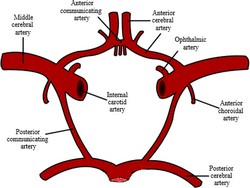
Medical Terminology Daily (MTD) is a blog sponsored by Clinical Anatomy Associates, Inc. as a service to the medical community. We post anatomical, medical or surgical terms, their meaning and usage, as well as biographical notes on anatomists, surgeons, and researchers through the ages. Be warned that some of the images used depict human anatomical specimens.
You are welcome to submit questions and suggestions using our "Contact Us" form. The information on this blog follows the terms on our "Privacy and Security Statement" and cannot be construed as medical guidance or instructions for treatment.
We have 2037 guests online

Georg Eduard Von Rindfleisch
(1836 – 1908)
German pathologist and histologist of Bavarian nobility ancestry. Rindfleisch studied medicine in Würzburg, Berlin, and Heidelberg, earning his MD in 1859 with the thesis “De Vasorum Genesi” (on the generation of vessels) under the tutelage of Rudolf Virchow (1821 - 1902). He then continued as a assistant to Virchow in a newly founded institute in Berlin. He then moved to Breslau in 1861 as an assistant to Rudolf Heidenhain (1834–1897), becoming a professor of pathological anatomy. In 1865 he became full professor in Bonn and in 1874 in Würzburg, where a new pathological institute was built according to his design (completed in 1878), where he worked until his retirement in 1906.
He was the first to describe the inflammatory background of multiple sclerosis in 1863, when he noted that demyelinated lesions have in their center small vessels that are surrounded by a leukocyte inflammatory infiltrate.
After extensive investigations, he suspected an infectious origin of tuberculosis - even before Robert Koch's detection of the tuberculosis bacillus in 1892. Rindfleisch 's special achievement is the description of the morphologically conspicuous macrophages in typhoid inflammation. His distinction between myocardial infarction and myocarditis in 1890 is also of lasting importance.
Associated eponyms
"Rindfleisch's folds": Usually a single semilunar fold of the serous surface of the pericardium around the origin of the aorta. Also known as the plica semilunaris aortæ.
"Rindfleisch's cells": Historical (and obsolete) name for eosinophilic leukocytes.
Personal note: G. Rindfleisch’s book “Traité D' Histologie Pathologique” 2nd edition (1873) is now part of my library. This book was translated from German to French by Dr. Frédéric Gross (1844-1927) , Associate Professor of the Medicine Faculty in Nancy, France. The book is dedicated to Dr. Theodore Billroth (1829-1894), an important surgeon whose pioneering work on subtotal gastrectomies paved the way for today’s robotic bariatric surgery. Dr. Miranda.
Sources:
1. "Stedmans Medical Eponyms" Forbis, P.; Bartolucci, SL; 1998 Williams and Wilkins
2. "Rindfleisch, Georg Eduard von (bayerischer Adel?)" Deutsche Biographie
3. "The pathology of multiple sclerosis and its evolution" Lassmann H. (1999) Philos Trans R Soc Lond B Biol Sci. 354 (1390): 1635–40.
4. “Traité D' Histologie Pathologique” G.E.
Rindfleisch 2nd Ed (1873) Ballieres et Fils. Paris, Translated by F Gross
"Clinical Anatomy Associates, Inc., and the contributors of "Medical Terminology Daily" wish to thank all individuals who donate their bodies and tissues for the advancement of education and research”.
Click here for more information
- Details
The prefix [erythr-] originates from the Greek [ερυθρός] (erythros) meaning "red". Applications of this include:
- Erythrocyte: The suffix [-(o)cyte] means "cell". A red cell, referring to a red blood cell
- Erythroblast: The suffix [-(o)blast] means "a germ" or "a sprout". An erythroblast is a red blood cell that has not matured yet and still contains a nucleus
- Erythroblastocyte: This is probably a better word, not used much, that refers to a red cell that is still a "sprout", not yet ready
- Erythropoieisis: The suffix [-(o)poieisis] means "to make". Refers to the process that creates red blood cells
Note: The links to Google Translate in these articles include an icon that will allow you to hear the Greek or Latin pronunciation of the word.
- Details
The root term [-dext-] and its variant [-dexter-] arise from the Latin [dexter] meaning "right". It may be pointed out that the modern Greek word for "right" is [δεξιά] (dexia), and they are probably related with the Latin term.
It is interesting that a word meaning "right" would be used in the word "dexterous" meaning "skilled". The reason is that the right hand, being the one most used by many is more skilled than the left hand.
The term [ambidextrous] is said to mean "someone skilled with both hands". In reality, it refers to a person that "has two right hands", therefore skilled with both hands.
- Details
The middle cerebral arteries are paired terminal branches of the internal carotid artery. Each middle cerebral artery supplies arterial blood to the brain beyond the arterial circle of Willis. The vascular territory of the middle cerebral artery supplies the lateral surfaces of the frontal, parietal, and temporal cerebral lobes as well as the deeply situated insular lobe.
There are many anatomical variations of the middle cerebral artery, as described here.
Clinical anatomy, pathology, and surgery of the brain and spinal cord are some of the lecture topics developed and delivered by Clinical Anatomy Associates, Inc.
Image modified from the original (in the public domain) by Sobotta (1945)
- Details
This article is part of the series "A Moment in History" where we honor those who have contributed to the growth of medical knowledge in the areas of anatomy, medicine, surgery, and medical research.

Click for a larger image
Dr. Húmer Hültl (1868 – 1940) Hungarian surgeon, Húmer Hültl was born in 1868 in Felsobanya. Hültl studied in Budapest, earning his medical degree in 1891, and after surgical training he started to work as a surgeon in 1893.
By 1900, Dr. Hültl was the chief surgeon at the St. Stephen’s Hospital and later at the Sr. Rokus Hospital, and during WWI he was a commander of a Hungarian military hospital. Dr. Hültl’s attention to detail, careful asepsis (after Ignaz Semmelweis) and superb surgical technique earned him the moniker “The Paganini of the Knife”. Hültl was the first in his country to introduce the use of face masks, gloves, sterile cotton, and rubber gloves.
Dr. Hültl was very concerned about the consequences of spillage of gastrointestinal contents in the peritoneal cavity during surgery, covering all the walls of the cavity with sterile towels. At that time some surgical instruments had been invented to keep the edges of the intestines together while suturing. In 1907 Dr. Hültl envisioned a mechanical instrument that could place rows of staples transversely in the intestines thus avoiding spillage. With the aid of Victor Fisher, a German mechanical engineer, the first surgical stapler was constructed.
This original instrument was very bulky and heavy, weighing close to 11 pounds, and used a “bicycle-chain” type of mechanism to push a crankshaft that would push the staples into the anvil to form “B” shaped staples. It placed four rows or staggered staples. This device was first used in surgery on May 9th, 1908. A later, lighter variation of the instrument was later created, with a different crankshaft and weighing 8 pounds. Images of these instruments are available here.
Not many of these instruments were sold, but Dr. Hültl had set the stage for the development of the modern surgical stapler. Even today we still use the basic principles of his surgical stapler: “B" shaped staples, staggered rows of staples, and attention to the avoidance of leakage through the staple line. All of this makes Dr. Hültl an integral part of the history of surgical stapling.
Sources:
1. "Húmer Hültl: The Father of the Surgical Stapler" Robicsek, F.& Konstantinov, I. J Med Biogr February 2001 9: 16-19
2. “Current Practice of Surgical Stapling" Ravitch, MM; Steichen, FM, 1991.
Original image courtesy of "Surgical Stapler Museum" at www.surgicalstaplermuseum.com
- Details
The root term [-mur-] has its origin in the Latin word [murus] and means "wall". In medical terminology it is used mostly as [-mural] meaning "pertaining to a wall". It can be used in the following terms:
• Transmural: Through a wall
• Extramural: Outside a wall
• Intramural: Within a wall
Another term meaning "wall" is [parietal] from the Greek word [paries].
- Details
In medical terms a [sign] is an objective, observable, measurable expression of a pathology. To a physician, the combination of a patient's clinical and familial history (anamnesis), combined with the patient's symptoms and signs allows for a proper diagnosis. Some signs are so subtle and specific that they can only be observed and understood by a trained health care professional. Furthermore, some signs are pathognomonic, that is, by their presence they define a pathology. Furthermore
Contrary to symptoms (which are subjective), signs are not only objective, but comparable between individuals of the same species. Therefore we can compare the heart rate bmp (beats per minute) between normal and sick individuals allowing us to chart a range from normal to abnormal. The same is true for most signs such as body temperature, respiratory capacity, breathing rate, weight, height, etc.
Some signs are particular to a pathology, although they may not be pathognomonic. These specific signs are usually eponymic, such as:
• McMurray's sign: A click caused by the meniscus during manipulation of the knee; indicative of meniscal injury.
• Blumberg's sign: Sharp piercing pain on the abrupt release of steady pressure over the site of a suspected abdominal lesion, indicative of peritonitis. When used to diagnose appendicitis over McBurney's point it may be called Aaron's sign.
• Musset's sign: Rhythmical jerking of the head following the heart pulsations in aortic aneurysm and aortic insufficiency.
• Cardarelli's sign: An abnormal pulsation of the trachea that may be found in patients with an aneurysm of the aortic arch that causes left tracheal displacement.
• Caput medusae: A ring of dilated varicose veins radiating from the umbilicus, usually indicative of portal hypertension.
• Papal Benediction Sign: A contraction of the fourth and fifth digits, as in benediction (see image).
There are many more medical signs, this list is only an illustration of the concept



